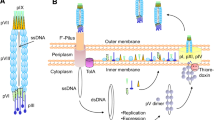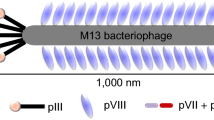Abstract
Peptide display on the phage surface has been widely used to identify specific peptides targeting several in vivo and in vitro tumor cells and the tumor vasculature, playing a role in the discovery of bioactive antitumor agents. Bioactive peptides have been selected to target important tumor receptors or apoptosis-associated molecules such as p53. Presently, we attempted to identify potentially antitumor bioactive molecules using the whole cell surface as the recognizable static matrix. Such methodology could be advantageous in cancer therapy because it does not require previous characterization of target molecules. Using a C7C phage display library, we screened for peptides binding to the B16F10-Nex2 melanoma cell surface after pre-absorption on melan-A lineage. After a few rounds of enrichment, 50 phages were randomly selected, amplified, and tested for inhibition of tumor cell proliferation. Seven were active, and the corresponding peptide of each phage was chemically synthesized in the cyclic form and tested in vitro. Three peptides were able to preferentially inhibit the melanoma lineage. A unique peptide, [-CSSRTMHHC-], exhibited in vivo antitumor inhibitory activity against a subcutaneous melanoma challenge, rendering 60% of mice without tumor growth. Further, this peptide also markedly inhibited in vitro and in vivo the tumor cell invasion and cell-to-cell adhesiveness in vitro. This is the first report on a bioactive peptide derived from a C7C library active against whole melanoma cells in vitro and in vivo.









Similar content being viewed by others
References
Miller AJ, Mihm MC (2006) Mechanisms of disease—melanoma. N Engl J Med 355:51–65
Ruoslahti E (2002) Drug targeting to specific vascular sites. Drug Discov Today 7:1138–1143
St Croix B, Rago C, Velculescu V, Traverso G, Romans KE, Montgomery E, Lal A, Riggins GJ, Lengauer C, Vogelstein B, Kinzler KW (2000) Genes expressed in human tumor endothelium. Science 289:1197–1202
Shadidi M, Sioud M (2002) Identification of novel carrier peptides for the specific delivery of therapeutics into cancer cells. Faseb J 16:256–258
Zhang BH, Zhang YQ, Wang JW, Zhang YD, Chen JJ, Pan YF, Ren LF, Hu ZY, Zhao JF, Liao MM, Wang SW (2007) Screening and identification of a targeting peptide to hepatocarcinoma from a phage display peptide library. Mol Med 13:246–254
Kolonin MG, Bover L, Sun J, Zurita AJ, Do KA, Lahdenranta J, Cardo-Vila M, Giordano RJ, Jaalouk DE, Ozawa MG, Moya CA, Souza GR, Staquicini FI, Kunyiasu A, Scudiero DA, Holbeck SL, Sausville EA, Arap W, Pasqualini R (2006) Ligand-directed surface profiling of human cancer cells with combinatorial peptide libraries. Cancer Res 66:34–40
Li ZH, Zhao RJ, Wu XH, Sun Y, Yao M, Li JJ, Xu YH, Gu JR (2005) Identification and characterization of a novel peptide ligand of epidermal growth factor receptor for targeted delivery of therapeutics. Faseb J 19:1978–1985
Hu SJ, Guo XN, Xie HH, Du YL, Pan YL, Shi YQ, Wang J, Hong L, Han S, Zhang DT, Huang DW, Zhang KD, Bai FH, Jiang HP, Zhai HH, Nie YZ, Wu KC, Fan DM (2006) Phage display selection of peptides that inhibit metastasis ability of gastric cancer cells with high liver-metastatic potential. Biochem Biophys Res Commun 341:964–972
Pasqualini R, Arap W (2002) Translation of vascular diversity into targeted therapeutics. Ann Hematol 81:S66–S67
Zhang JB, Spring H, Schwab M (2001) Neuroblastoma tumor cell-binding peptides identified through random peptide phage display. Cancer Lett 171:153–164
Hong FD, Clayman GL (2000) Isolation of a peptide for targeted drug delivery into human head and neck solid tumors. Cancer Res 60:6551–6556
Kay BK, Kurakin AV, Hyde-DeRuyscher R (1998) From peptides to drugs via phage display. Drug Discov Today 3:370–378
Lee JH, Engler JA, Collawn JF, Moore BA (2001) Receptor mediated uptake of peptides that bind the human transferrin receptor. Eur J Biochem 268:2004–2012
Ladner RC, Sato AK, Gorzelany J, de Souza M (2004) Phage display-derived peptides as a therapeutic alternatives to antibodies. Drug Discov Today 9:525–529
Eriksson F, Culp WD, Massey R, Egevad L, Garland D, Persson MAA, Pisa P (2007) Tumor specific phage particles promote tumor regression in a mouse melanoma model. Cancer Immunol Immunother 56:677–687
Howell RC, Revskaya E, Pazo V, Nosanchuk JD, Casadevall A, Dadachova E (2007) Phage display library derived peptides that bind to human tumor melanin as potential vehicles for targeted radionuclide therapy of metastatic melanoma. Bioconjug Chem 18:1739–1748
Wu J, Wu MC, Zhang LF, Lei JY, Feng L, Jin J (2009) Identification of binding peptides of the ADAM15 disintegrin domain using phage display. J Biosci 34:213–220
Paschoalin T, Carmona AK, Rodrigues EG, Oliveira V, Monteiro HP, Juliano MA, Juliano L, Travassos LR (2007) Characterization of thimet oligopeptidase and neurolysin activities in B16F10-Nex2 tumor cells and their involvement in angiogenesis and tumor growth. Mol Cancer 6:44–58
Hirata IY, Cezari MHS, Nakaie C (1994) Internally quenched fluorogenic peptide substrates: solid phase, synthesis and fluorescence spectroscopy of peptides containing orthoaminobenzoil/dinitrophenyl groups as donor acceptor-pairs. Lett Peptide Sci 1:299–308
Dobroff AS, Rodrigues EG, Moraes JZ, Travassos LR (2002) Protective, anti-tumor monoclonal antibody recognizes a conformational epitope similar to melibiose at the surface of invasive murine melanoma cells. Hybrid Hybridomics 21:321–331
Pasqualini R, Ruoslahti E (1996) Organ targeting in vivo using phage display peptide libraries. Nature 380:364–366
Kennel SJ, Mirzadeh S, Hurst GB, Foote LJ, Lankford TK, Glowienka KA, Chappell LL, Kelso JR, Davern SM, Safavy A, Brechbiel MW (2000) Labeling and distribution of linear peptides identified using in vivo phage display selection for tumors. Nucl Med Biol 27:815–825
Oliveira V, Campos M, Hemerly JP, Ferro ES, Camargo ACM, Juliano MA, Juliano L (2001) Selective neurotensin-derived internally quenched fluorogenic substrates for neurolysin (EC 3.4.24.16): comparison with thimet oligopeptidase (EC 3.4.24.15) and neprilysin (EC 3.4.24.11). Anal Biochem 292:257–265
Guimaraes-Ferreira CA, Rodrigues EG, Mortaray RA, Cabralz H, Serrano FA, Ribeiro-dos-Santos R, Travassos LR (2007) Antitumor effects in vitro and in vivo and mechanisms of protection against melanoma B16F10-Nex2 cells by fastuosain, a cysteine proteinase from Bromelia fastuosa. Neoplasia 9:723–733
Franken NAP, Rodermond HM, Stap J, Haveman J, van Bree C (2006) Clonogenic assay of cells in vitro. Nat Protoc 1:2315–2319
Scott JK, Smith GP (1990) Searching for peptide ligands with an epitope library. Science 249:386–390
Sioud M, Forre O, Dybwad A (1996) Selection of ligands for polyclonal antibodies from random peptide libraries: potential identification of (auto)antigens that may trigger B and T cell responses in autoimmune diseases. Clin Immunol and Immunopathol 79:105–114
Kolonin M, Pasqualini R, Arap W (2001) Molecular addresses in blood vessels as targets for therapy. Curr Opin Chem Biol 5:308–313
Mummert ME, Mummert DI, Ellinger L, Takashima A (2003) Functional roles of hyaluronan in B16-F10 melanoma growth and experimental metastasis in mice. Mol Cancer Ther 2:295–300
Agiostratidou G, Li MM, Suyama K, Badano I, Keren R, Chung S, Anzovino A, Hulit J, Qian BZ, Bouzahzah B, Eugenin E, Loudig O, Phillips GR, Locker J, Hazan RB (2009) Loss of retinal cadherin facilitates mammary tumor progression and metastasis. Cancer Res 69:5030–5038
Takeichi M, Watabe M, Shibamoto S, Ito F, Oda H, Uemura T, Shimamura K (1993) Dynamic control of cell–cell adhesion for multicellular organization. C R Acad Sci Serie III 316:818–821
Liu LX, Lee NP, Chan VW, Xue W, Zender L, Zhang CS, Mao M, Dai HY, Wang XL, Xu MZ, Lee TK, Ng IO, Chen YC, Kung HF, Lowe SW, Poon RTP, Wang JH, Luk JM (2009) Targeting cadherin-17 inactivates Wnt signaling and inhibits tumor growth in liver carcinoma. Hepatology 50:1453–1463
Zhou J, Li JM, Chen JZ, Liu YH, Gao WZ, Ding YQ (2009) Over-expression of CDH22 is associated with tumor progression in colorectal cancer. Tumor Biol 30:130–140
Acknowledgments
The present work was supported by Fundação de Amparo à Pesquisa do Estado de São Paulo (FAPESP) and the Conselho Nacional de Desenvolvimento Científico e Tecnológico (CNPq).
Disclosure of potential conflict of interests
The authors declare no conflict of interests related to this study.
Author information
Authors and Affiliations
Corresponding author
Rights and permissions
About this article
Cite this article
Matsuo, A.L., Tanaka, A.S., Juliano, M.A. et al. A novel melanoma-targeting peptide screened by phage display exhibits antitumor activity. J Mol Med 88, 1255–1264 (2010). https://doi.org/10.1007/s00109-010-0671-9
Received:
Revised:
Accepted:
Published:
Issue Date:
DOI: https://doi.org/10.1007/s00109-010-0671-9




